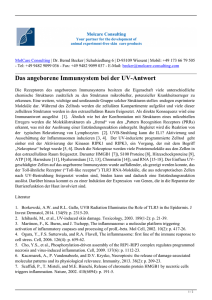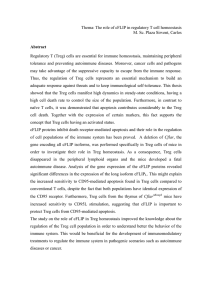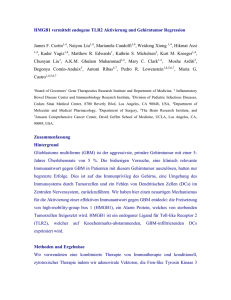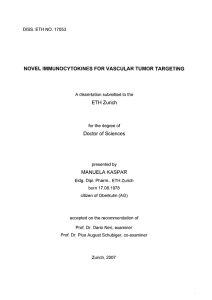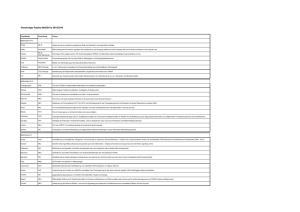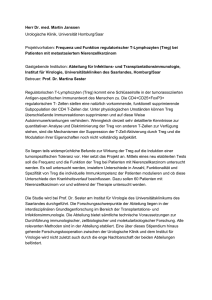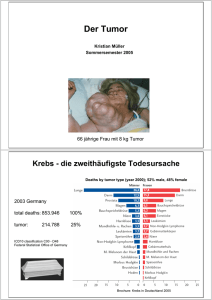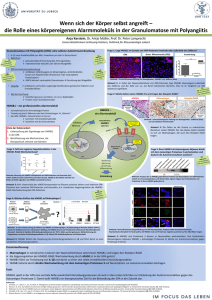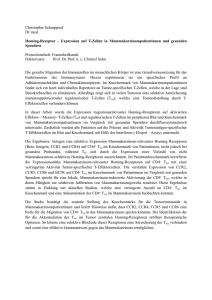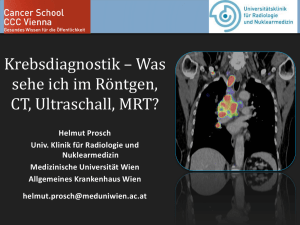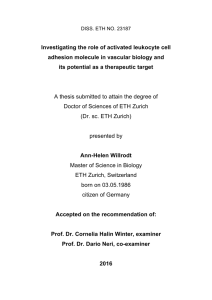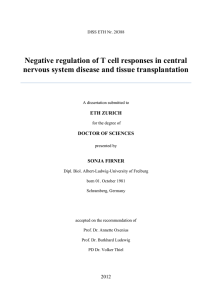Dissertation Abstract C. Wild
Werbung
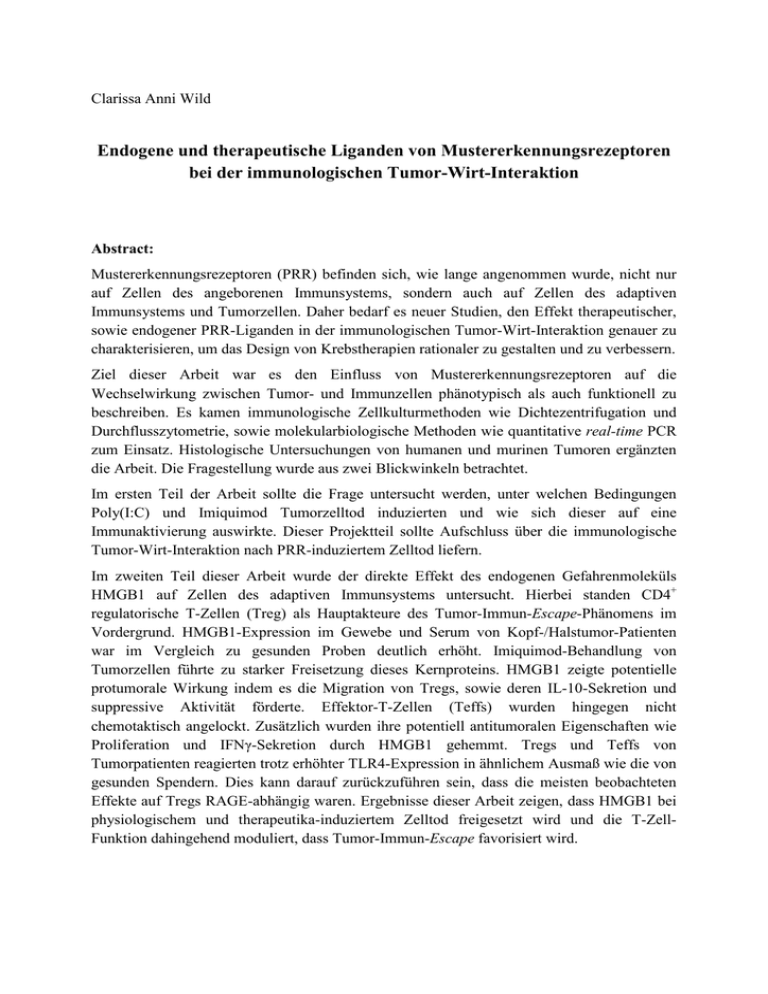
Clarissa Anni Wild Endogene und therapeutische Liganden von Mustererkennungsrezeptoren bei der immunologischen Tumor-Wirt-Interaktion Abstract: Mustererkennungsrezeptoren (PRR) befinden sich, wie lange angenommen wurde, nicht nur auf Zellen des angeborenen Immunsystems, sondern auch auf Zellen des adaptiven Immunsystems und Tumorzellen. Daher bedarf es neuer Studien, den Effekt therapeutischer, sowie endogener PRR-Liganden in der immunologischen Tumor-Wirt-Interaktion genauer zu charakterisieren, um das Design von Krebstherapien rationaler zu gestalten und zu verbessern. Ziel dieser Arbeit war es den Einfluss von Mustererkennungsrezeptoren auf die Wechselwirkung zwischen Tumor- und Immunzellen phänotypisch als auch funktionell zu beschreiben. Es kamen immunologische Zellkulturmethoden wie Dichtezentrifugation und Durchflusszytometrie, sowie molekularbiologische Methoden wie quantitative real-time PCR zum Einsatz. Histologische Untersuchungen von humanen und murinen Tumoren ergänzten die Arbeit. Die Fragestellung wurde aus zwei Blickwinkeln betrachtet. Im ersten Teil der Arbeit sollte die Frage untersucht werden, unter welchen Bedingungen Poly(I:C) und Imiquimod Tumorzelltod induzierten und wie sich dieser auf eine Immunaktivierung auswirkte. Dieser Projektteil sollte Aufschluss über die immunologische Tumor-Wirt-Interaktion nach PRR-induziertem Zelltod liefern. Im zweiten Teil dieser Arbeit wurde der direkte Effekt des endogenen Gefahrenmoleküls HMGB1 auf Zellen des adaptiven Immunsystems untersucht. Hierbei standen CD4+ regulatorische T-Zellen (Treg) als Hauptakteure des Tumor-Immun-Escape-Phänomens im Vordergrund. HMGB1-Expression im Gewebe und Serum von Kopf-/Halstumor-Patienten war im Vergleich zu gesunden Proben deutlich erhöht. Imiquimod-Behandlung von Tumorzellen führte zu starker Freisetzung dieses Kernproteins. HMGB1 zeigte potentielle protumorale Wirkung indem es die Migration von Tregs, sowie deren IL-10-Sekretion und suppressive Aktivität förderte. Effektor-T-Zellen (Teffs) wurden hingegen nicht chemotaktisch angelockt. Zusätzlich wurden ihre potentiell antitumoralen Eigenschaften wie Proliferation und IFNγ-Sekretion durch HMGB1 gehemmt. Tregs und Teffs von Tumorpatienten reagierten trotz erhöhter TLR4-Expression in ähnlichem Ausmaß wie die von gesunden Spendern. Dies kann darauf zurückzuführen sein, dass die meisten beobachteten Effekte auf Tregs RAGE-abhängig waren. Ergebnisse dieser Arbeit zeigen, dass HMGB1 bei physiologischem und therapeutika-induziertem Zelltod freigesetzt wird und die T-ZellFunktion dahingehend moduliert, dass Tumor-Immun-Escape favorisiert wird. Abstract in english: The pattern recognition receptors (PRRs) belong to an evolutionary highly conserved receptor family responsible for recognizing pathogen associated molecular pattern molecules (PAMPs) and danger associated molecular pattern molecules (DAMPs). A long period of time it was assumed that they are localized mainly on immune cells notably cells of the innate immune system. It was recently found that also tumor cells can express PRRs and that their challenge can induce cancer cell death. During cell death endogenous DAMPs are released and can act on surrounding tissue. Thus, PRR-based immunotherapy may lead to a, until now unknown complex tumor-immune cross talk within the tumor microenvironment. Aim of this thesis was to elucidate this interaction on phenotypical and functional levels. Cell culture methods like density centrifugation and flow cytometry were used as well as molecular biological methods like quantitative real-time PCR. Histological analyses of human and murine tumors were also applied. The objective was investigated from two perspectives. In the first part, the effect of head and neck cancer (HNC) cell stimulation by the therapeutic PRR ligands Poly(I:C) and Imiquimod and the consequences for interaction with immune cells was investigated. This part should elucidate tumor-immune interaction after PRRinduced tumor cell death. In the second part of the project we asked whether the endogenous danger molecule HMGB1 (high mobility group box 1 protein) can directly modulate T lymphocytes focusing on regulatory T cells (Treg) as the main players in tumor immune escape phenomenon. During tumor cell death, endogenous DAMPs can be released, that bind to PRRs on tumor cells themselves or on immune cells. HMGB1 is the most prominent DAMP, binds to TLR2, TLR4 and RAGE on target cells and can be released during necrotic or chemotherapy-induced tumor cell death. Interestingly, we found that HMGB1 is overexpressed in tumor cells of patients with HNC, that serum levels are significantly elevated in these patients compared to healthy donors, and that Imiquimod-induced cell death results in release of HMGB1 by tumor cells. We found that HMGB1 induced directed migration in Treg and not effector T cells (Teff). Additionally, HMGB1 promoted regulatory characteristics of Treg such as suppressive activity and IL-10 release. At the same time HMGB1 reduced anti-tumoral effector functions of Teff like proliferation and IFNγ release. Unexpectedly, increased expression of TLR4 on Treg and Teff in HNC patients did not result in enhanced activation of Treg in patients compared to healthy donors. This may be explained by the fact that HMGB1 modulates Treg via RAGE. Our findings demonstrate that HMGB1 can be released from HNC cells during homeostatic or therapy-induced cell death and differentially modulates functions of Treg and Teff in the tumor host favoring tumor immune escape.
